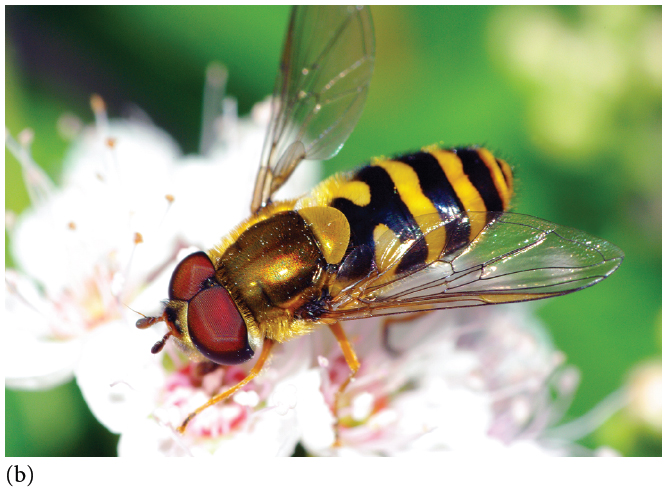 |
| Previous Image | Next Image |
| Description: Most prey species are masters of defence, one of the most basic means of which is camouflage. Quite simply, predators can not eat prey they can not find. The efficiency of this defence can be astounding, as shown by Bernd Heinrich (1984) in a study of predatory bald-faced hornets. The hornets hunt other insects by flying rapidly among the plants in their environment and pouncing on objects that may be prey. Because their prey are well camouflaged, the hornets often pounce on inanimate objects. Heinrich was able to observe 260 pounces by hornets. About 70% of these were directed at inanimate objects, such as bird droppings and brown spots on leaves. Another 20% were directed at insects, such as bumblebees and other wasps, insects too well defended to be prey. Only 7% of the pounces were on potential insect prey! The hornets managed to capture two of these, a moth and a fly. Heinrich's observations indicate bald-faced hornets have a prey capture rate of less than 1%! Not all prey species are hidden to predators, and instead many prey are coloured to be extremely visually apparent. This can be seen in the striking colours displayed by many butterflies, snakes, and nudibranchs. How can prey persist with such colouration? Many of these animals are toxic. Prey that carry a threat to predators often advertise that fact, usually by being brightly coloured or conspicuous in some other way. The conspicuous colours, or aposematic colouration, of many distasteful or toxic animals warn predators that “feeding on me may be hazardous to your health.†However, such a signal is not perfect. For example, one of the authors of this text (J.C.) enjoyed catching butterflies as a young boy. I recall well the bright sunny day that I decided the Monarch just looked so beautiful that I promptly licked its wings for a taste. Needless to say, the Monarch was advertising truthfully: its colouration is associated with a variety of foul tasting compounds. Lest you think that I am the sole potential predator of species with aposematic colouration, many predatory species need to learn to associate colouration with toxicity. Only for a subset of species is this “knowledge†an innate trait of the species. The curious predator is not the only potential threat to species with warning colouration. In Batesian mimicry, a harmless (nontoxic) species will exhibit colouration similar to that of a noxious species that lives in the same area. For example, king snakes mimic the poisonous coral snakes, Viceroy butterflies mimic the noxious Monarch butterfly, and syphid flies mimic stinging bees. Batesian mimics elude predation not through the actual ability to defend themselves from attack, but instead by using the learned (and innate) abilities of predators to associate harm with particular colours and patterns. What do you imagine might happen if in a given community the frequency of mimics exceeds the frequency of actually toxic models? Mullerian mimicry is also common, and can enhance the learning by potential predators associated with aposematic colouration. Mullerian mimics are all toxic/noxious, and share similar colouration. For example, you may have noticed that many stinging flies, wasps, and bees, three distantly related groups of taxa, have superficially similar appearances that include yellow and black stripes. These are Mullerian mimics. One likely advantage of similar colouration is that potential predators are likely to encounter toxic/noxious organisms with similar colouration more frequently than if only one species has such colouration. As a result, it is thought that Mullerian mimicry systems enhance the rate at which predators learn to associate a particular colour/pattern with risk, thereby reducing predation risk for these species. However, you may have noticed that some flies share the same colouration, yet do not sting. These are Batesian mimics of Mullerian mimics
Picture Stats: Views: 830 Filesize: 308.97kB Height: 490 Width: 666 Source: https://biology-forums.com/index.php?action=gallery;sa=view;id=1967 |
